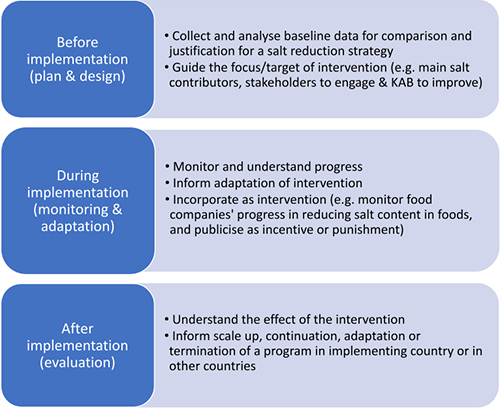Why it matters
Collecting data is important to inform the intervention, to monitor the extent to which it is being implemented effectively and having the intended effect, and to evaluate the impact of the intervention. It is important to do surveillance before (plan & design), during (monitoring & adaptation) and after (evaluation) program implementation. The figure below shows how the findings from surveillance and monitoring can be used at each stage of a program.

How to do it
Surveillance usually involves measuring and monitoring of the population’s:
- salt intake levels,
- dietary sources of salt and salt content in foods,
- salt-related knowledge, attitudes and behaviours (KAB)
1. Population salt intake levels
The information related to salt can be collected through existing data, as part of existing or planned surveys, or a new stand-alone survey.
The procedures on measuring population salt intake levels using the gold standard approach of 24-hour urine collection are described in detail in PAHO’s Protocol for population level sodium determination (Resource 1).
When planning and budgeting for a survey as part of an existing survey (e.g. WHO NCD STEPS survey) or a new survey, it is important to understand calculate the sample size needed to precisely estimate salt intake for the different groups of interest (e.g. men vs women, or young vs old) and/or to detect change over time (Tool 1). Next, it is important to obtain international or local ethics approval and obtain informed consent from participants (Tool 2 and 3), before collecting data. Finally, it is critical to provide participants with the instructions on how to accurately collect 24-hour or spot urine samples (Tool 4).
2. Dietary sources of salt and salt content in foods
Sodium in our diet comes from salt added during manufacturing of packaged foods and beverages, natural levels of sodium in foods, salt added in meals cooked by chefs, and salt added by the consumer during cooking or at the table. There are various methods for assessing the dietary sources of salt in the diet, and combination of procedures should be used to understand the complete profile of dietary sources of salt. This is described in detail in WHO’s A review of methods to determine the main sources of salt in the diet (Resource 2).
The most common methods for understanding the sources of salt in the diet of a population is to conduct dietary assessments to measure food intake for e.g. a 24-hour dietary recall survey (Tool 5), or a food frequency questionnaire (Tool 6). After measuring food intake, in order to estimate salt from each food or meal, it is important to measure salt content (or concentration) in foods. A common approach is to conduct a shop survey to record the salt or sodium concentration labelled on packaged food products (Tool 7 and 8), because in many countries, it is mandatory for food companies to declare the sodium or salt concentration on packaged foods.
3. Consumers’ salt-related knowledge, attitudes and behaviours (KAB)
Individuals or consumers’ knowledge, attitudes and behaviour related to salt plays an important role in the amount of salt consumed, therefore it is important to measure as part of the existing or standalone surveys. A commonly used salt-related knowledge, attitudes and behaviour questionnaire are the core salt questions as part of WHO STEPS NCD risk factor survey (Tool 9 and Resource 3). Using a standardised questionnaire allows for international comparison, however questions should be added or tailored to suit the dietary practices in the country.